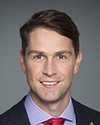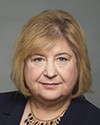Thank you, Madam Chair.
Cowessess First Nation is in the Treaty 4 territory. I see one of my colleagues, a tribal chief. Edmund spoke earlier. We're from a similar area.
Cowessess First Nation has 4,259 citizens. Just under 1,000 live on the homelands, and everybody else lives nomadically throughout Treaty 4 and beyond. Our average age at home is around 35, and we have a lot of baby boomers wanting to move home or living at home.
I have three quick stories which will give you more of a personal touch.
A man named Bruce who passed away in October got dementia about two years ago. He was a leader for many years in the community. He passed away when he was 69. In his last year he was admitted to Broadview Centennial Lodge, a residence about 23 kilometres north of Cowessess. He was a harmless person, but because of dementia, he had a few aggressive moments, unfortunately. Sometimes he would be tied to his wheelchair because the nurses didn't know what to do. He was trying to leave and stuff like that. It was very emotional for the family to see a loved one being treated like that. I have no disrespect for the lodge; I know they had very limited resources.
Bruce was conscious enough that he knew he wasn't at home on the reserve. Every day he would have that drive to try to get back home. All he wanted was to be back home. Unfortunately, the dementia got the best of him, and then he passed away.
The second story is about a lady by the name of Maggie Redwood. She passed away about a year ago. She was 101. Her family refused to put her in a home. She was at the stage where her family did everything for her. They changed her and bathed her. They pretty much fed her. The family got very fatigued in the last two years of her life, only because they had to sacrifice their own jobs and their own personal time. They refused to allow her to live in a home off the reserve. It took a toll on the family to honour their grandmother, great-grandmother, great-great-grandmother, but they allowed her to live out her days in a standard house on Cowessess, giving that stage 3 support from within their means.
The last one is Harold Lerat. He is currently with us. Harold thinks he's on the reserve, but he's in a home. You talk to him, and he says that his horses are outside, and his reserve house is there. It gets to the family once in a while when they have to go to Broadview again but they don't want to break his heart, and tell him he's not at home.
Those are three stories to start, given the need that long-term care definitely has to make its way back to the homelands.
In Cowessess we separate them into three age categories. The under 21 and the 22 to 54 have certain needs and wants in life. The 55-plus want two things. They want security and they want to know that someone's looking after them. Sometimes when you get to stages 2, 3, and 4, some of them will not say much because they don't want to fear getting removed from their house and put into a lodge. It's to the point where they will hurt themselves trying to pretend that everything's all right. The ultimate thing is they don't want to leave. They don't want to be looked after off the reserve. They want to stay home.
We have different categories. We have some in stage 2 that require some basic needs. Maybe they don't need to be in permanent long-term care, but definitely need something close to home where they could go on a daily basis, even if it's a nurse or constant updates and things like that. They still can maintain a basic life.
When it comes to emergency services when we talk about long-term care and the goal to get more on the reserve, you have to assess the emergency services, and how long it will take an ambulance to get to the reserve, how long it takes to find the location. We're being a little more proactive about it here on Cowessess First Nation.
The next one is partnerships. Reserves, first nations, and bands can't do this alone. On Cowessess First Nation we have neighbouring nations—Sakimay, Kahkewistahaw, Ochapowace. We're dealing with this long-term care thing together. We're discussing it and seeing how we can partner to have economies of scale.
Even beyond that, there are jurisdiction differences because the first nation is on status land. As my friend said earlier with respect to lands set aside for Indians, there's sometimes a jurisdiction issue when it comes to the province.
One thing Cowessess First Nation is doing is meeting with its provincial partners to let them know we don't need to talk about jurisdiction since we know we have differences, and to see if we can get some care on the reserve, respect jurisdiction, and try to figure it out. Those conversations are starting to happen.
Cowessess First Nation has citizens who are RNs and LPNs. They have the qualifications. Some are working in the local lodges in the cities. The human capital is already there, and they're ready to move home.. It's just a matter of getting a little more overall capital infrastructure, if that's the goal.
I go to the home quite regularly just to visit, and many people there, first nation and non-first nation, are forgotten. Some of them don't get visits and some get very few visits. When you walk into a long-term home, they're so excited to see you. They all want to talk to you. One thing Cowessess does is hold a local powwow at the Broadview Centennial Lodge just to bring a little bit of culture to them and get them visiting.
One of our action plans is to have a long-term home on Cowessess, and we have it in our plans to put a day care with it. When it comes to seniors, one of the best medicines is their grandkids, great-grandkids, and children. To have a long-term care facility in the same building as a day care, where our next generation is getting primed up to be leaders, provides a balance and interaction between the two.
Sometimes there's culture shock when seniors have to leave the reserve. When you have a certain lifestyle and you maintain a certain character, whether it's humour or intergenerational trauma if it's related to residential school, there's culture shock. Sometimes in these provincial areas, nurses who are taught to deliver services are sometimes not taught the cultural awareness. That culture shock means a lot, and I notice it's also something that has to be included.
I can't figure it out, but the reality is that a senior in long-term care has no problem being buried at home or finding a final resting place, but when it comes time for those last five years of their life, they are not allowed to be on the reserve because we don't have the services. There's something not correct in that area, and I know that when we put all our minds together, we can figure it out.
Finally, I just want to say that I'm really excited to be a part of this. I want to end off by saying that it's not just about long-term care of our seniors. Cowessess also has some adults in stage 3 and stage 4 who live with their grandparents, and to some degree it's elder abuse because the elders don't know what to do with their grandkids. I know this may not be the committee that talks about that part, but I just wanted to throw that in there. When it comes to stage 3 and stage 4 long-term care, there are others on Cowessess who aren't elders and whose situation also needs to be addressed, so we need to figure this out. We can't forget that younger generation.
Thank you.



